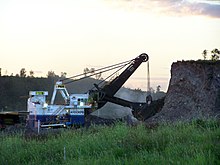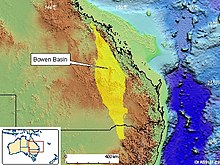Fairview gas field
The Fairview gas field is developed by the Comet Ridge Project, a coal seam gas extraction project in the Bowen Basin. Fairview is PL 91 located in the Comet Ridge Project Area comprising PLs 90, 91, 92, 99,100, 232, 233,234, 235 and 236 and ATPs 526P, 653P, 655P and 745P, some 500-600 kilometres north-west of Brisbane or 100-200 kilometres north of Roma. Total area is approximately 5,000 square kilometres, stretching 175 kilometres to the north from Injune.
The project is operated by Santos Limited, which has a net revenue interest of 76.07%, and a working interest of 79.5%. Santos acquired the Comet Ridge coal seam gas project comprising Fairview and 4,000 square kilometres of exploration acreage in 2005 through the acquisition and subsequent merger of Tipperary Corporation's Australian assets into the Santos gas portfolio. [10] The remaining participants, which include origin parties, hold a combined net revenue interest of 22.93%, and a working interest of 20.5%.
The discovery well, the Fairview 1, was drilled in August 1994, followed by a number of other wells which subsequently began dewatering to establish the technical and commercial viability of coal seam gas. Gas production started in January 1995, with the first sales of gas in February 1998. More than 100 wells have been drilled at year-end 2005, with some 80 wells in the Fairview area. Of these, 57 are connected and producing to the gathering system with the remainder undergoing dewatering operations and/or awaiting completion and connection.
Gas is gathered to two compressor sites (CS1 and CS2) where it is compressed and dehydrated before export as sales to the Fairview lateral of the Queensland Gas Pipeline system. Following the merger into Santos’ operations on 28 October 2005 and the subsequent integration, extra compression has been brought online and additional wells connected, which has increased sales gas production by 66%. Sales gas production is around 45 TJ/day, limited by the capacity of the export pipeline. Average well productivity is around 0.9 TJ/day, with a number of wells flowing in excess of 5 TJ/day.
Development during 2006 includes the construction of a new 130-kilometre pipeline from CS2 to Wallumbilla, expansion of the gas processing facilities, and drilling and connection of additional wells. This will increase sales gas capacity to 70 TJ/day in 2007. In the longer term, additional development and facilities will enable sales gas production to be increased to approximately 200 TJ/day in 2012, with Santos share approximately 140 TJ/day.
Scotia gas field
The Scotia gas field is in the Bowen Basin, onshore Eastern Queensland, approximately 340 kilometres north-west of Brisbane and 145 kilometres north-east of Roma on the Burunga anticline within PL 176. The area of PL 176 is approximately 213 square kilometres. Santos has a 100% working interest in the project.
The discovery well, the Scotia 3, was drilled in 1996. It was the first well drilled to test the late Permian coal seam gas play. Coal seam methane gas production started in 2002. Under a 15-year contract the field supplies CS Energy's gas-fired power station. [11]
The total investment to date is approximately A$65 million. The Scotia field comprises 25 connected wells gathered into a central processing facility. The processing includes water separation, glycol dehydration and four-stage compression. Sales gas is transported via a 111-kilometre Scotia/Peat lateral pipeline to join the Roma to Brisbane Pipeline, about 116 kilometres east of Wallumbilla.



